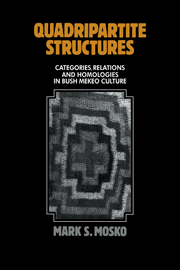Book contents
- Frontmatter
- Contents
- List of figures, tables, and maps
- Preface
- 1 Introduction: the problem and the people
- 2 Between village and bush
- 3 Body and cosmos
- 4 Sex, procreation, and menstruation
- 5 Male and female
- 6 Kin, clan, and connubium
- 7 Feasts of death (i): de-conception and re-conception
- 8 Feasts of death (ii): the sons of Akaisa
- 9 Tikopia and the Trobriands
- 10 Conclusions: indigenous categories, cultural wholes, and historical process
- Appendixes
- Notes
- Bibliography
- Index
9 - Tikopia and the Trobriands
Published online by Cambridge University Press: 04 August 2010
- Frontmatter
- Contents
- List of figures, tables, and maps
- Preface
- 1 Introduction: the problem and the people
- 2 Between village and bush
- 3 Body and cosmos
- 4 Sex, procreation, and menstruation
- 5 Male and female
- 6 Kin, clan, and connubium
- 7 Feasts of death (i): de-conception and re-conception
- 8 Feasts of death (ii): the sons of Akaisa
- 9 Tikopia and the Trobriands
- 10 Conclusions: indigenous categories, cultural wholes, and historical process
- Appendixes
- Notes
- Bibliography
- Index
Summary
The foregoing chapters have been devoted to interpreting diverse contexts of Bush Mekeo social life and to building in the process a model of the total culture. With the ethnographic treatment of the indigenous conceptualizations of death and mortuary feasting, that goal is now rendered virtually complete. The structure that characterizes Bush Mekeo culture overall, as I have shown, is consistently quadripartite in form. However, the implications for comparison and culture theory that arise from this derivation have yet to be considered. It is to these complementary issues that this and the concluding chapter are respectively addressed.
For the present purpose of comparison, I have chosen the cultures of Tikopia and the Trobriand Islands. These two unquestionably represent the most extensively documented and well-known ethnographic cases in the Oceanic sphere, if not in the entire anthropological record. Firth and Malinowski, the original ethnographers, are both regarded even today as among the most meticulous observers and recorders to have ever lived. Their classic functionalist descriptions have been supplemented by more modern and diverse interpretations, some but not all of them sympathetic with a general structuralist perspective like my own. And particularly in the case of the Trobriands, the original ethnographic corpus has been substantially augmented and clarified with more recent firsthand fieldwork. For these several reasons, then, Tikopia and the Trobriands each represents a preeminent challenge for structuralist interpretation along the lines of my analysis of Bush Mekeo culture.
- Type
- Chapter
- Information
- Quadripartite StructuresCategories, Relations and Homologies in Bush Mekeo Culture, pp. 200 - 233Publisher: Cambridge University PressPrint publication year: 1985



